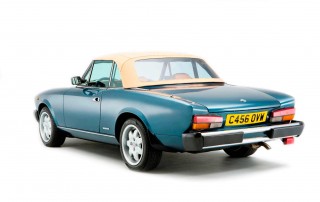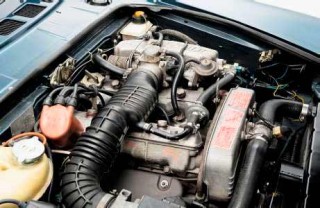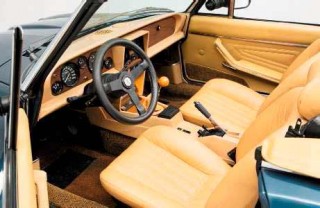The new Mazda-based Fiat 124 Spider is driving interest and values for the Tom Tjaarda-penned original. For good reason – twin-cam engine, five-speed ’box, four-wheel disc brakes, easy-to-use soft-top; the 124 Spider was cutting edge in 1966 and remained in production for 19 years.

The driving experience is remarkably good and easy-going too, and with thorough rust protection these cars can still make surprisingly good everyday classics. Some of this guide is based on my own experience of buying a 1985 model from Germany in the early 2000s and running it as my daily driver for two years. But we have also called upon the encyclopaedic knowledge of British specialist Paul De Turris of DTR European Sports Cars (02086 455050; dtrsports.com), who has been selling, restoring and providing parts for Fiat Spiders for more than 27 years. He says, ‘The recent rise in values has seen quite a few continental cars of dubious quality arrive in the UK. They photograph well but that’s where the good stuff ends!’ This guide should help you avoid those.
Which one to choose?
As with MGBs, it’s the pre-impact bumper models that are preferred and which therefore cost the most money. Numbers of these are steadily increasing in the UK, unlike later models.
It would take a lot more space than we have here to detail the various body code and detail changes – from AS to DS with various numbered sub-species – so we’ll keep it simple with three phases: chrome bumper cars, those with impact bumpers, and Pininfarina Spiders from when that company took over production in 1981. There’s one exception – the AS code cars, built from 1966-1969 and notable for their flat bonnets and 1438cc engines, are starting to attract collectors who value their design purity. Later cars got double-hump bonnets whose bumps grew in phases. The ASs were also significantly lighter than later Spiders and that small-sounding 1.4-litre engine produces 96bhp and equivalent performance to a 1.8-litre MGB.
Least favoured are the 1975-1981 cars, which were built exclusively for the American market and – that old story – got impact bumpers and an increased ride height. These rubber-padded chrome bars added 350lb at the same time as emission controls were sapping power from their 1.6 or 1.8 engines, especially on Californian cars. However, many European imports will have been de-smogged, which is good, or even given later and larger engines. This is also perceived as good and doesn’t harm values except on AS models.
By the time Pininfarina took over production at the end of 1981 and badged its first own-brand cars Pininfarina Spider Europa (in Europe) and Azzurra (in the US), carburettors had been replaced by Bosch fuel injection, improving economy and emissions, and engine capacity was up to two litres. If you can live with the impact bumpers (or even if not – we’ll come to that) these are the best option for regular use or classic tours. A way to identify later cars is that from 1979 they switched from grab-type door handles to lush-mounted ones shared with the Alfa Spider and various Ferraris, whose bodies were also made by Pininfarina.
Body matters
If ever you needed encouragement to follow that old cliché and buy the best, the 124 Spider provides it. De Turris reckons it takes 700-900 hours to restore one, so even if you can find someone to do it for £20 an hour the man-maths really don’t add up. And unless the car is a fresh southern States import, much of that work will be on the body because these were Italian cars that got no factory rust-prevention treatment. De Turris also cautions that from 1979 the steel used was appalling and reckons that on the older cars lasts three times as long. There is fairly decent panel availability but good-quality stuff is drying up and some pattern parts are poor. Front wings are £286, or £188 for pattern ones; rears are £678, or £258 for three-quarter repair sections. If you’re looking at a car that needs bodywork, do your sums with those numbers to calculate whether it’s worth it.
Doors are becoming a big issue and are one of the first areas to display rot – you can find it in the corners even in supposed dry-state imports. You can get skins for £88, but you can only get complete new doors for 1966-1969 cars at £1000-plus each, or right-hand doors for post-’1979 cars at £787. Also there are three different types of striker plate for each of our chosen eras, which means doors are not easily interchangeable between different ages of Spider. In effect, any car with rust in the door frames is best avoided.
Underneath
Chassis legs can crack where the front crossmember bolts on, which loosens the mounting bolts. This is often revealed by creaking noises on the test drive, but you can also check by trying to turn the bolts with a 17mm spanner. Repairs here are often tricky and time-consuming and it’s probably best considered a deal-breaker.
Don’t be fooled by smart outer sills – they’re just cosmetic bolt-on panels. It’s what’s behind them that counts and needs careful checking from beneath. The three-part sills total more than £250 per side in panels, and fitting can add another £1500 a side.
Always check on the condition of floorpans (or past repairs to them) around where the rear axle location arms mount. If not done correctly – and with years of low values a lot of these cars have been run on tight budgets – you can wind up with a misaligned rear axle.
Running gear
It used to be that you could almost ignore the condition of the engine – they were an advanced design and but also very tough and vice-free. There was also a ready supply of cheap secondhand Mirafiori units to draw on, but that has all but dried up now. So listen for any rumbles or rattles of discontent; the exhaust might be fruity, but the engine itself should be smooth, making faults easy to spot. These are easy engines to work on, but parts are expensive – easily totalling £1000 on their own – so a full professional rebuild can end up costing £4-5k, or you can buy a fresh unit from Germany ready-to-fit, but that’s also around £4000. On the plus side, it’s an opportunity to replace a power-strangled US-spec engine with a higher compression European unit. The added performance can help you forget the bill.
Most of the gearboxes are tough and long-lived too, apart from those in the Pininfarina cars which were of an inferior quality. They tend to fail without warning so there are no checks to make, and replacement with a unit from an earlier car is the best solution. In general listen for whining in all gears, which shouldn’t be there and is a sign of coming expense, as is any dropping out of gear on the over-run. Exchange reconditioned ’boxes are around £1200.
Interior and hood
Less of a worry, in fact more of a bargaining point, the inside of the car is well served by 124 parts specialists. You can buy a complete trim set for £2000-2200, or even upgrade to leather seats for around £500 more. Just make sure the seat frames are good – they are often broken by drivers leaning behind to raise the hood. On that subject, a new top is in the region of £750 fitted. Add another £200 if the header rail is rusting and needs replacement. And check this, especially near each end, when you inspect a car. Squeeze it and feel for any crunchiness and give.
Improvements
As touched on earlier, improving performance through removing emissions gear and even swapping in larger engines from other Fiats that used the twin-cam can actually improve a car’s appeal and value. Another popular mod with US imports is to it European-spec springs to get the ride height down and improve the handling on post-1974 cars. You’re in luck if it’s already been done, but if not a set of springs costs almost £200 plus a similar amount for fitting.
A growing number of impact-bumper cars is being fitted with the more delicate bumpers of earlier cars, which are available new for £525 a set, and you can buy the brackets to carry out the conversion from Spider- Point in Germany for £130. If that sounds like a lot of money, it’s now not uncommon to find corrosion in the twin tubes of the impact bumpers – and a new pair of those can set you back £900 without any of the rubber sections or light housings. If nothing else, that cost threat makes it another area to check carefully.

Engines are generally tough, vice-free and easy to work on, though parts are pricey if you do need to do a rebuild. Interior parts are readily available from 124 specialists, but check the seat frames are sound. Not surprisingly, corrosion is the biggest potential deal breaker – find a car with sound bodywork or expect some very big restoration bills.
Owning a 124 Spider
Gary Pass, Berkshire
Gary bought his very late 1985 Pininfarina Spider Europa in May 2016 after a trip to long-time 124 specialist DTR European Sports Cars. ‘I had a Barchetta before, which DTR did a cambelt on. While there I started looking at these. They were a lot of money but I thought it may prove an investment after the new model came out. Paul offered me this one to drive away for one price or with fresh paint, seats and hood for a lot more. I decided to spend the money up front and have a really nice car. I also had Euro-spec springs fitted because it had US ones and rode too high for my liking, and the wheels look like the originals but have one less spoke and are 15in rather than 14in. They’re thought to have been on the car since it was new, or close to.
‘I’m only the third owner, and both previous ones were Swiss, the second bringing it to the UK with him 15 years ago. DTR looked after it for him but he didn’t use it much – it’s still only done 123,000km, which is about 76,000 miles. I’ve done around 3000 of those since buying it – I drive whenever I can without getting it wet! My son is a mechanic but all we’ve done so far is carry out an oil change and some basic checks. Get a good one of these they can be surprisingly affordable to run.’
Ari Kyrtatas, Montreal
Ari picked up his 1979 Spider nine years ago. It had been restored between 2002-2004 and painted Ferrari Rosso Corsa but no other history came with it. ‘Living in the rust belt capital of Canada, keeping the body protected is of most importance. The car is kept in a climate-controlled environment year-round. After the floorpans – they are still the original panels with no patches – were stripped and coated with POR-15 rustproofing paint, the rest of the car was treated with a gel-like rustproof coating. It has remained corrosion-free since.
‘It’s simpler to find parts now than it was one or even two decades ago because of all the remanufactured parts now available, and these cars are durable and reliable. They are also very capable devourers of miles. I’ll soon be driving it to this year’s Fiat Freakout in Milwaukee, Wisconsin, which is 800 miles away. With that in mind the propshaft has recently been fitted with a new rubber doughnut and universal joints and balanced. It’s perfectly smooth and quiet at high speeds now.
‘My Spider looks period-correct but has been fitted with Vogtland progressive lowering springs and ‘street’ grade polyurethane bushes on the suspension control arms. It rides and handles really well. Once you get them up to standard they are very cheap cars to run.’
Steve Ferrari, California
Steve bought his ‘1972 Spider from the original owner in 2000. ‘At the time the car had only 42,000 miles on it and still wore its original tyres complete with inner tubes. The seller told me, “Change the timing belt, water pump and tensioner every three years, even if you never drive it. Don’t cheat any of the maintenance tasks and the car won’t let you down.” And in 17 years I’ve only had one breakdown – when an ignition rotor cracked. It was the one component I’d never changed because it was stuck and I didn’t want to risk breaking anything prying it of. So he was right. Finding the Miraiori forum proved to be the best thing for keeping the car on the road. I’m not a mechanic but with the forum’s help I’ve rebuilt brakes, changed a head gasket and installed electronic ignition. Luckily most parts are still available new.’
One for sale
1979 Fiat 124 Spider – £8995
Two-litre Californian import. New steel central exhaust section removes the power-sapping cat’. Huge history file with receipts for thousands of pounds. Recently replaced interior trim including carpets, door cards and navy, silver-piped leather. Nor much used for the past eight years. Currently SORN. Needs cosmetic work on three areas including dash top. New old-style radio accepts iPhone or iPod.

The pre-1975 slim-bumpered models are the most soughtafter generation, followed by the later Pininfarina-built example like this, which had 2-litre engines with fuel injection.
What to pay
The best restored pre-1975 slim-bumper cars can make £30k, with even projects fetching £3500 and driver-quality stuff in the teens.
Similar US-only era (1975-1981) impact-bumper models rarely get as high as. £20k, with decent projects from £2500.
The price goes up again for ’1981-on Pininfarina cars by around 10 per cent.
Top money is for limited-run performance models – you can pay more than £40k for an Abarth or over £25k for a 700 Turbo or 500 Volumex (supercharged) car.
‘As an everyday classic the driving experience is remarkably good and easy-going ’
‘There is fairly decent panel availability but the good-quality stuff is drying up’





